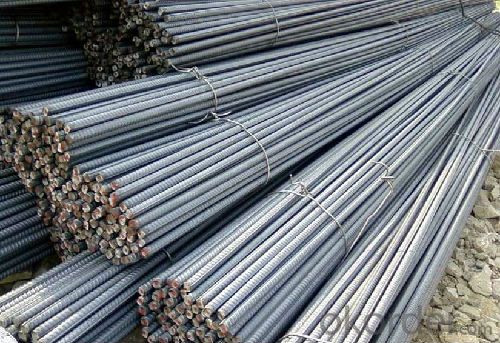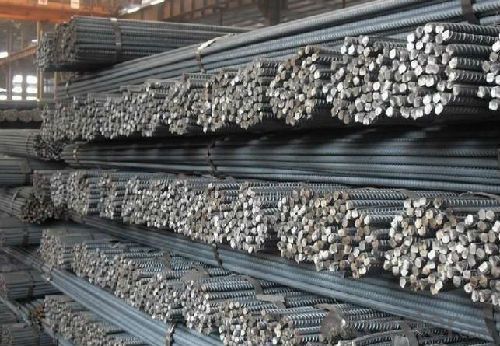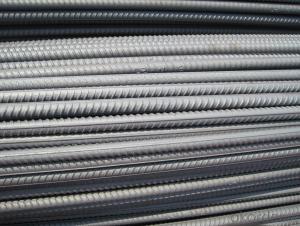High Quality Steel Deformed Bar HRB400 25/28/32mm
- Loading Port:
- Tianjin
- Payment Terms:
- TT or LC
- Min Order Qty:
- 100 m.t
- Supply Capability:
- 10000 m.t/month
OKorder Service Pledge
OKorder Financial Service
You Might Also Like
High Quality Steel Deformed Bar HRB400 25/28/32mm
Product Description:
Specifications of High Quality Steel Deformed Bar HRB400 25/28/32mm:
Standard | GB | HRB400 | |
Diameter | 25mm,28mm,32mm | ||
Length | 6M, 12M | ||
Place of origin | Hebei, China mainland | ||
Advantages | exact size, regular package, chemical and mechanical properties are stable. | ||
Type | Hot rolled deformed steel bar | ||
Chemical Composition of High Quality Steel Deformed Bar HRB400 25/28/32mm: (Please kindly find our chemistry of our material based on HRB400 as below for your information)
Grade | Technical data of the original chemical composition (%) | ||||||
C | Mn | Si | S | P | V | ||
HRB400 | ≤0.25 | ≤1.60 | ≤0.80 | ≤0.045 | ≤0.045 | 0.04-0.12 | |
Physical capability | |||||||
Yield Strength (N/cm²) | Tensile Strength (N/cm²) | Elongation (%) | |||||
≥400 | ≥570 | ≥14 | |||||
Theoretical weight and section area of High Quality Steel Deformed Bar HRB400 25/28/32mm as below for your information:
Diameter(mm) | Section area (mm²) | Mass(kg/m) | Weight of 12m bar(kg) |
25 | 490.9 | 3.85 | 46.2 |
28 | 615.8 | 4.83 | 57.96 |
32 | 804.2 | 6.31 | 75.72 |
Usage and Applications of High Quality Steel Deformed Bar HRB400 25/28/32mm:
Deformed bar is widely used in buildings, bridges, roads and other engineering construction. Big to highways, railways, bridges, culverts, tunnels, public facilities such as flood control, dam, small to housing construction, beam, column, wall and the foundation of the plate, deformed bar is an integral structure material. With the development of world economy and the vigorous development of infrastructure construction, real estate, the demand for deformed bar will be larger and larger.
Packaging & Delivery of High Quality Steel Deformed Bar HRB400 25/28/32mm:
Packaging Detail: products are packed in bundle and then shipped by container or bulk vessel, deformed bar is usually naked strapping delivery, when storing, please pay attention to moisture proof. The performance of rust will produce adverse effect.
Each bundle weight: 2-3MT, or as required
Payment term: TT or L/C
Delivery Detail: within 45 days after received advanced payment or LC.
Label: to be specified by customer, generally, each bundle has 1-2 labels
Trade terms: FOB, CFR, CIF
FAQ:
Q1: Why buy Materials & Equipment from OKorder.com?
A1: All products offered byOKorder.com are carefully selected from China's most reliable manufacturing enterprises. Through its ISO certifications, OKorder.com adheres to the highest standards and a commitment to supply chain safety and customer satisfaction.
Q2: How do we guarantee the quality of our products?
A2: We have established an advanced quality management system which conducts strict quality tests at every step, from raw materials to the final product. At the same time, we provide extensive follow-up service assurances as required.
Q3: How soon can we receive the product after purchase?
A3: Within three days of placing an order, we will arrange production. The shipping date is dependent upon the quatity, how many sizes you want and the plan of production, but is typically 1 month to 2 month days from the beginning of production.
Images of High Quality Steel Deformed Bar HRB400 25/28/32mm:


*If you would like to get our price, please inform us the size, standard/material and quantity. Thank you very much for your attention.
- Q:How are steel rebars tested for quality and strength?
- Quality and strength of steel rebars are assessed through a series of standardized tests, ensuring adherence to required standards and ability to withstand anticipated loads and stresses. A primary test is the Tensile Test, which measures the maximum stress a rebar can endure before breaking. A sample rebar is pulled until it fractures, and the force needed to cause this fracture is measured. This test offers valuable data about the rebar's ultimate tensile strength, yield strength, and elongation. Another critical examination is the Bend Test, which evaluates the rebar's ductility and ability to resist breaking when bent. A sample rebar is bent to a specific angle, and any cracks or fractures are closely inspected. If there are no indications of failure, the rebar is considered acceptable. Furthermore, Chemical Analysis is performed to determine the rebar's chemical composition. This test ensures compliance with required chemical composition standards, as variations can impact the rebar's strength and durability. The Dimensional Test is conducted to verify that the rebar meets the specified standards in terms of dimensions, weight, and shape. Deviations from the required measurements can compromise the rebar's structural integrity. Additionally, the rebar's Surface Condition is visually evaluated to identify signs of rust, cracks, or other defects that could affect its performance. Proper surface condition is crucial for ensuring effective bonding with the surrounding concrete. Lastly, certain rebars undergo Non-Destructive Testing, such as ultrasonic testing or magnetic particle inspection, to identify hidden defects or cracks that may not be visible to the naked eye. In conclusion, these testing methods guarantee that steel rebars possess the necessary quality and strength for use in construction projects, providing essential reinforcement for reinforced concrete structures.
- Q:How do steel rebars contribute to the overall seismic performance of a structure?
- Steel rebars contribute to the overall seismic performance of a structure by enhancing its strength, ductility, and energy dissipation capacity. These reinforcement bars are embedded in concrete and help to resist the forces generated during an earthquake. By providing tensile strength to the concrete, rebars prevent cracks and brittle failure, enabling the structure to withstand the seismic forces and safely dissipate the energy. Overall, steel rebars significantly improve the resilience and structural integrity of buildings during seismic events.
- Q:What is the recommended method for splicing steel rebars together?
- The recommended method for splicing steel rebars together is typically achieved using mechanical splices or lap splices. Mechanical splices involve connecting two rebars using couplers or sleeves, which are designed to provide strength and stability to the joint. Lap splices, on the other hand, involve overlapping the rebars and securing them together with steel wire or tie bars. The choice of method depends on factors such as the structural requirements, rebar diameter, and construction specifications.
- Q:Are steel rebars magnetic?
- Yes, steel rebars are magnetic because they are primarily made of carbon steel, which is a ferromagnetic material.
- Q:What is the impact of steel rebars on the aesthetics of a structure?
- Steel rebars, being an essential component of reinforced concrete structures, generally have minimal impact on the aesthetics of a building. They are typically concealed within the structure and remain hidden from view. However, in certain architectural designs where rebars are intentionally exposed, they can contribute to an industrial or modern aesthetic. Overall, the impact of steel rebars on the aesthetics of a structure is largely dependent on the design intent and whether they are meant to be visible or not.
- Q:How do steel rebars affect the cost of a construction project?
- Steel rebars can significantly affect the cost of a construction project because they are a crucial component in reinforced concrete structures. The cost of steel rebars depends on their quantity, grade, and size, and it can greatly impact the overall project budget. Additionally, the transportation and installation costs associated with steel rebars should also be taken into account. Therefore, careful planning and consideration of the type and amount of steel rebars required are essential to manage and optimize the project's cost.
- Q:How do steel rebars contribute to the overall stiffness of a structure?
- Steel rebars contribute to the overall stiffness of a structure by providing reinforcement and enhancing its load-bearing capacity. When embedded within concrete, steel rebars form a composite material known as reinforced concrete, which combines the compressive strength of concrete with the tensile strength of steel. The primary function of steel rebars is to resist tensile forces that can cause concrete to crack or fail. Concrete has excellent compressive strength but is weak in tension. By adding steel rebars, the overall stiffness of the structure is increased, as the rebars take up the tensile stresses and prevent the concrete from failing under tension. The rebars are strategically placed within the concrete to resist anticipated forces and distribute them evenly across the structure. As external loads are applied to the structure, such as the weight of the building or environmental forces like wind or earthquakes, the rebars counteract the tension caused by these loads. This reinforcement ensures that the structure remains intact and stable, preventing any major deformations or collapse. Moreover, steel rebars also contribute to the ductility of the structure. Ductility refers to the ability of a material to undergo deformation without fracturing. Steel has high ductility, and when incorporated into reinforced concrete, it allows the structure to withstand some level of flexure and movement without compromising its overall strength and stability. This improved ductility enhances the structural resilience, making the building more resistant to extreme external forces. In summary, steel rebars play a crucial role in contributing to the overall stiffness of a structure by reinforcing the concrete and providing tensile strength. They prevent cracking and failure under tension, distribute forces evenly, and increase the structural resilience and ductility. By combining the compressive strength of concrete with the tensile strength of steel, steel rebars ensure that the structure can withstand various loads and maintain its stability and integrity over time.
- Q:What are the guidelines for installing steel rebars in concrete columns?
- The guidelines for installing steel rebars in concrete columns typically include ensuring the proper spacing and alignment of the rebars, using appropriate reinforcement sizes and types, securely tying the rebars at intersections, providing sufficient cover for the rebars, and ensuring proper anchorage and lap length for effective structural integrity. It is also important to follow any specific regulations or requirements outlined by local building codes or project specifications.
- Q:What are the different types of steel used in the production of rebars?
- There are typically three types of steel used in the production of rebars: carbon steel, low-alloy steel, and stainless steel. Carbon steel rebars are the most commonly used and have a high tensile strength. Low-alloy steel rebars contain additional elements like chromium, nickel, or molybdenum for enhanced strength and durability. Stainless steel rebars are corrosion-resistant and often used in environments with high exposure to moisture or chemicals.
- Q:What are steel rebars made of?
- Steel rebars, also known as reinforcement bars, are primarily made of carbon steel. Carbon steel is an alloy of iron and carbon, with other elements such as manganese, silicon, and copper added in small quantities to enhance its properties. The carbon content in steel rebars is typically around 0.2% to 0.3%, which provides the necessary strength and durability required for reinforcing concrete structures. The steel used for rebars undergoes a process called hot rolling, where it is heated to high temperatures and then passed through rollers to form the desired shape and size. This process helps to improve the mechanical properties and structural integrity of the rebars, making them suitable for applications that require added strength and support in concrete construction.
1. Manufacturer Overview |
|
|---|---|
| Location | |
| Year Established | |
| Annual Output Value | |
| Main Markets | |
| Company Certifications | |
2. Manufacturer Certificates |
|
|---|---|
| a) Certification Name | |
| Range | |
| Reference | |
| Validity Period | |
3. Manufacturer Capability |
|
|---|---|
| a)Trade Capacity | |
| Nearest Port | |
| Export Percentage | |
| No.of Employees in Trade Department | |
| Language Spoken: | |
| b)Factory Information | |
| Factory Size: | |
| No. of Production Lines | |
| Contract Manufacturing | |
| Product Price Range | |
Send your message to us
High Quality Steel Deformed Bar HRB400 25/28/32mm
- Loading Port:
- Tianjin
- Payment Terms:
- TT or LC
- Min Order Qty:
- 100 m.t
- Supply Capability:
- 10000 m.t/month
OKorder Service Pledge
OKorder Financial Service
Similar products
New products
Hot products
Hot Searches
Related keywords





























